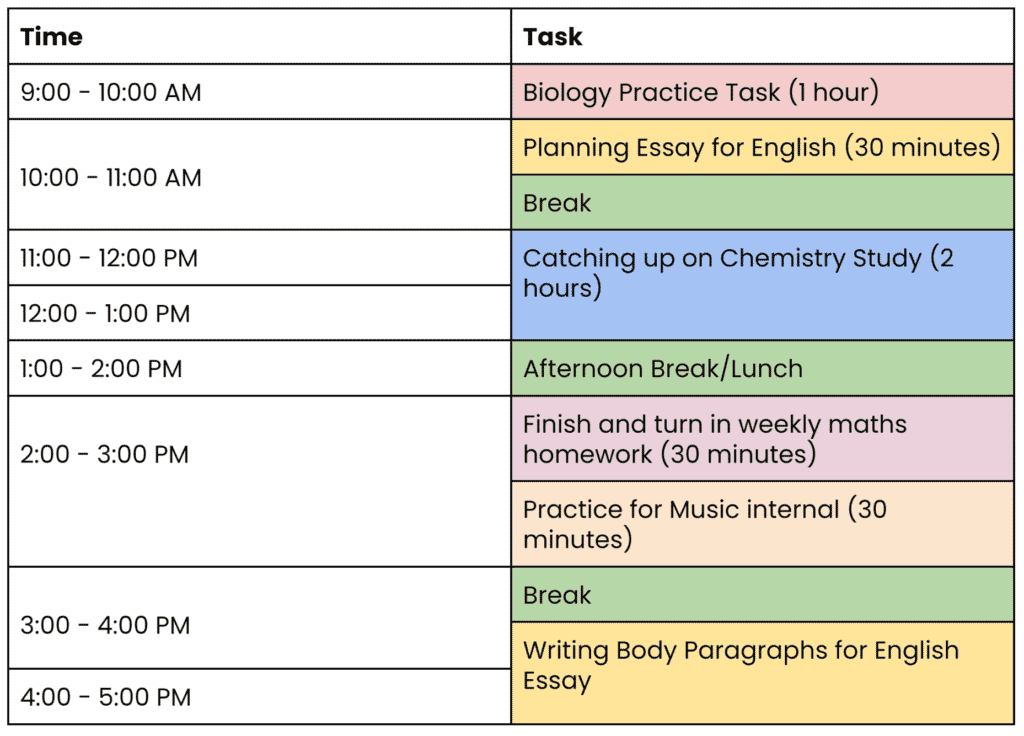We’re almost halfway through the year and with COVID-19, a truckload of assessments, and just life in general, it can be easy to start slipping behind. Once you’re there it can feel like you’ll never catch up and your list of tasks just keeps growing and growing, and no matter how hard you try, it’s impossible to finish it.
Never fear! We’ve got you. This handy how-to guide will help you step you through what to do to get back on track and stay there.
Step 1: Write it all down
We need to start off by figuring out what exactly needs doing. Go through all your class pages, either on Teams, Google Classroom, or whatever you use, and make a list of everything that you’ve missed. That means noting down assessments or tasks that you didn’t submit or have yet to submit, any content learning you need to catch up on, and any other tasks your teachers have set for you.
Don’t worry if it looks massive now, we’ll tackle that in a minute. Remember to note down due dates, because those will be helpful in the next step.

How to prioritise!
Now that we know what we need to do, we can start prioritising. Prioritising means figuring out what’s most important so that you can work on that first. Getting the most important and stressful things done will help reduce the pressure on you and maximise your brain power.
You might be thinking, how can I prioritise when everything is important? After all, you’ve probably been putting some things off for a while. That’s not a problem because the Eisenhower Matrix can help us sort things out.

The Eisenhower Matrix helps you figure out where to start. Take the list you just made and sort them into these four categories:
- Important and urgent
- Important but not urgent
- Urgent but not important
- Not important and not urgent
Well what’s the difference between important and urgent you might ask?
Urgent tasks have a ticking timer on them. There is a due date that you need to meet which means they need to be done within a certain time frame. That history essay which is due in 3 days, that’s an urgent task.
Important tasks are things that will help you achieve your goals. Say you’ve set a goal to get an endorsement in chemistry. You might then classify chemistry tasks as more important than music tasks.
Here’s an example of what a simple Eisenhower Matrix might look like:

Once you’ve sorted your tasks into these boxes it’s way easier to prioritise well. Tasks in the Urgent and Important box are the tasks you want to do first because they have a timeframe and they’ll get you to your goals. So get them done and dusted.
For tasks that fall into either important but not urgent, or urgent but not important, you’ll have to do a bit more work on deciding when to do them.
If something is due soon you might want to get it out of the way to get those credits in the bag. If it’s something really important to you, like an art internal that isn’t due for a while, you might want to dedicate a bit of time to it so you’re not stressing about it last-minute.
Finally, we have the not important and not urgent tasks.
These are the tasks that come last. It may even be worth going through this list and seeing if you can eliminate anything. For example, that worksheet you needed to complete for maths 3 weeks ago may be redundant now, and your time will be better spent on other tasks.
Set Goals
Now that you’ve got your priorities straight you can start setting yourself some goals. Don’t miss this step, even if you’re anxious to get started – it’s easy to run out of motivation and your goals will keep you on track. This step only needs to take about 15 minutes.
Think about what you want to achieve today, and what do you want to achieve by the end of the week? Setting weekly goals is a good method, because if you plan too far ahead you’ll forget about those goals, or you might find that plans change and you need to rethink your goals anyway.
Remember to make your goals realistic so that you can actually achieve them. This makes your brain super happy and keeps you motivated to keep going.

Step 2: Get studying!
If you’ve finished step 1 you’ve now got a plan in place, give yourself a pat on the back. You’re on your way to getting back on track. Now it’s time to start your study.
To help you get there even faster we’ve collated a few handy study methods that will increase your productivity.
Timeboxing
Have you ever been told that tasks expand or shrink to fit the time that’s available to us? This is why you can write that essay your teacher gave you 2 weeks ago in 2 hours before it’s due.
We’re not encouraging you to write your essays at the last minute but we can utilise this phenomenon to get the most out of your day. To do so we’ll use a method called timeboxing, also sometimes referred to as “chunking”. This method is designed to help you manage your time and be super productive.

Timeboxing involves taking the priority list we made earlier and estimating how much time each task will take. For example: biology practice task = 1 hour. Then you can put these into your daily schedule or even a weekly calendar. Don’t forget to add in breaks or you’ll burn yourself out.
Here’s an example:

Set a timer for each task, when it goes off, you stop working regardless of where you’re at, and you move on.
If you only have a little bit of time after school, plan to timebox just that amount of time. It’s still effective and will help you stay focused.
You might be asking, what if I don’t give myself enough time? That’s totally okay. It’s actually an important part of timeboxing to do a little reflection on your method. If you didn’t set enough time or if you set yourself too much time and found that you were messing around halfway through then you can adjust your estimations for next time.
Single-tasking
But why is multitasking so bad? Doesn’t it mean you can get more done? The term multitasking is misleading, while it might feel like you’re doing more your brain actually has to switch focus every time you switch tasks, and that gets super tiring pretty fast.
When you focus on one thing at a time you’re putting your full brain power into it. This means you can get it done way faster, increased productivity here we come!
We don’t mean to sound like your parents, but it’s true, picking up your phone when you get a notification or checking your emails still counts as multitasking because it’s changing your brain’s focus. So get rid of distractions, put your phone in another room if you have to and be amazed by how fast you can finish things!
The 10 Minute Rule
Sometimes no matter how well you’ve planned things out you just can’t seem to get started. This is where the 10-minute rule might be able to help out.
Pretty much every student is familiar with the feeling of being so stressed out that you don’t want to do any of your tasks, even though you know that completing them will take away your stress. This is your brain protecting you from discomfort by stopping you from doing the things that are stressing you out, even though they’re exactly the things you should be doing.
The 10-minute rule scales tasks down to get past this mental block. How does it work?
- Tell yourself you’re only going to spend 10 minutes on your task. Set a timer.
- Once the time is up you get to decide, stop or continue?
If you want to stop working that’s totally fine, at least you did a little bit. Take a break and try the 10-minute rule out again later. However, most people will find that after 10 minutes they’ve got the momentum to keep going.
To really beat your brain, practice working with the mindset, “I’m only going to do X for 10 minutes”. For example: “I don’t need to do the entire SciPad chapter, I only need to spend 10 minutes doing the first couple of pages”. Then once 10 minutes are up, you’ll probably find you’ve got your head in the game and you can do the rest of the chapter.

Staying Motivated
When you’re catching up you’ve got way more than the usual amount of work. This can make staying motivated even harder. Here are some tips to help you stay on track.
- Take things one step at a time. Each thing you get done helps you catch up so give yourself a pat on the back every time you finish something. Rewarding yourself with little things is also a good strategy.
- Stick to your goals. This gives you something to work towards and having an endpoint in sight can make it easier to push through. Try telling people your goals so they can hold you accountable.
- Take breaks. This stops you from burning out and helps maintain your focus.
Practice reflecting and reframing your thinking. Sometimes you won’t get everything done and stuff can interfere with your plans. Be gentle and kind to yourself. Remember your health comes before your studies and something is always better than nothing.
Step 3: Keep the Ball Rolling
So you’ve put in the mahi and you’re back on track!

What’s even better is that now you have all the tools you need to stay on track. Create an Eisenhower matrix each week to keep track of everything you need to do. Timebox your week to make it super productive. If you find yourself procrastinating, try out the 10-minute rule. Finally, remember to single-task to get through things faster.
To round things off
If you find that you’ve fallen behind, there’s nothing to be ashamed of. It happens to the best of us. With the holidays coming up and mock exams approaching, now is the perfect time to get yourself back on track.
Catching up takes a bit of short-term hard work and time, but we believe in you, and with these handy tips you’ve just finished reading about, you’ll be back where you want to be in no time.

0 Comments